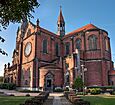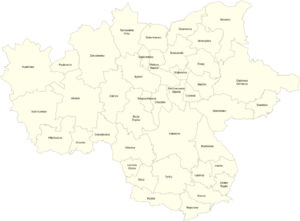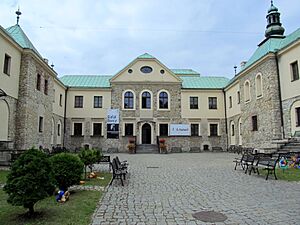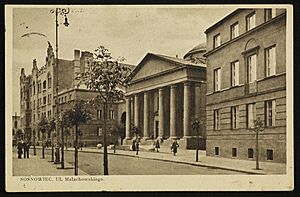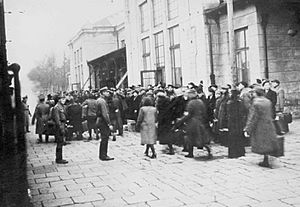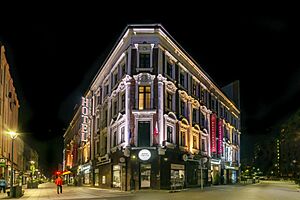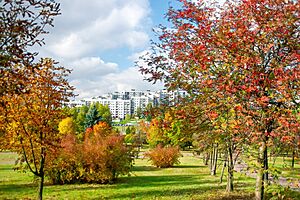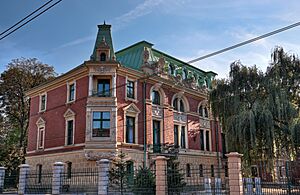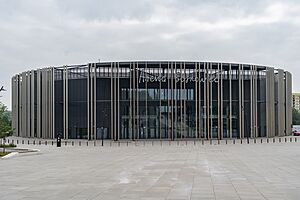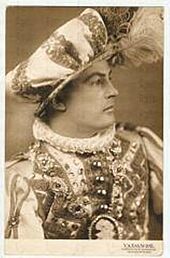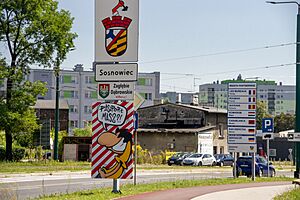Sosnowiec facts for kids
Quick facts for kids
Sosnowiec
|
|||||
|---|---|---|---|---|---|
|
|||||
|
|||||
| Country | |||||
| Voivodeship | |||||
| County | city county | ||||
| City rights | 1902 | ||||
| Area | |||||
| • City | 90.16 km2 (34.81 sq mi) | ||||
| Elevation | 250 m (820 ft) | ||||
| Population
(31 December 2022)
|
|||||
| • City | 189,178 |
||||
| • Density | 2,075/km2 (5,370/sq mi) | ||||
| • Urban | 2,746,000 | ||||
| • Metro | 4,620,624 | ||||
| Time zone | UTC+1 (CET) | ||||
| • Summer (DST) | UTC+2 (CEST) | ||||
| Postal code |
41-200 to 41-225
|
||||
| Area code(s) | +48 32 | ||||
| Car plates | SO | ||||
| Primary airport | Katowice Airport | ||||
Sosnowiec (pronounced: sos-NOH-vyets) is a city in southern Poland. It is known for its industrial past. Sosnowiec is located in the Silesian Voivodeship and is part of a large group of cities called the Metropolis GZM. It is also part of the bigger Katowice urban area, which has about 2.7 million people. The even larger Katowice-Ostrava metropolitan area has around 5.3 million people. As of December 2022, Sosnowiec has a population of about 189,178 people.
Contents
Exploring Sosnowiec's Location
The name Sosnowiec likely comes from the Polish word sosna, which means "pine tree". This is because many pine forests grew in the area a long time ago. The village was first called Sosnowice. There are a few other small places in Poland with the same name.
Sosnowiec is an important center in a region of southern Poland called Zagłębie Dąbrowskie. It is located in the historic Lesser Poland area, close to the border with Silesia. The city is about 10 kilometers (6 miles) northeast of Katowice and 65 kilometers (40 miles) northwest of Kraków. It sits on the Silesian Upland near the Brynica and Przemsza rivers. These rivers are part of the Vistula river system. Since 1999, Sosnowiec has been part of the Silesian Voivodeship. Before that, it was part of the Katowice Voivodeship.
A Look at Sosnowiec's History
Early Beginnings
The city of Sosnowiec officially began in 1902. This is when several older villages joined together to form one city. However, the village of Sosnowiec was first mentioned way back in 1227. It was a small settlement near bigger villages like Sielce and Zagórze, which are now parts of Sosnowiec. Other areas of the city are even older. For example, Milowice was first mentioned in 1123.
Sosnowiec was part of the Polish–Lithuanian Commonwealth. It was a border town after the nearby areas of Silesia became part of the Bohemian Crown in 1335. In 1795, after the third partition of Poland, Sosnowiec was taken over by the Kingdom of Prussia. Later, during the Napoleonic Wars, it became part of the Duchy of Warsaw in 1807. Then, it was part of Congress Poland, which was ruled by the Russian Empire.
Sosnowiec was famous for the Three Emperors' Corner. This was a special spot where the borders of the German Empire, Austria-Hungary, and Russia met. In February 1863, during the January Uprising, Polish fighters won a battle against the Russians in Sosnowiec. This victory helped them take control of nearby towns.
Becoming a City
On June 10, 1902, Emperor Nicholas II of Russia officially made Sosnowiec a city. It covered an area of 19 square kilometers (7.3 square miles) and had 60,000 people. Becoming a city helped Sosnowiec grow economically and culturally. New factories, like steelworks and coal mines, opened. Many cultural places, like theaters, were also built. The new city included areas that used to be separate villages, such as Pogoń and Sielec. The Russian authorities had waited a long time to grant Sosnowiec city rights. This was seen as a punishment for the local support of the Polish January Uprising in 1863-64.
Sosnowiec grew quickly because of its natural resources and good location. The opening of a railway line in 1859 was very important for its growth. New industries, like rope and wire factories, steelworks, and paper mills, changed the town into a busy urban center. The Summer Theatre and Winter Theatre were founded. The Winter Theatre later became the Theatre of Zagłębie. In 1915, the village of Środula also became part of Sosnowiec.
Poland became independent again in 1918 after World War I. Sosnowiec became part of the Kielce Voivodeship. In 1934, the City County of Sosnowiec was created. Sosnowiec faced challenges during both World War I and World War II. World War I mostly damaged its industries. World War II brought difficult times for the people.
World War II and Its Impact
After the 1939 Invasion of Poland, the city was taken over by Nazi Germany. It was renamed Sosnowitz. On September 4, 1939, German troops killed 10 Poles in Sosnowiec, including a 15-year-old boy. This was done in revenge for Polish defense. The German police searched many Polish homes. Sosnowiec was later added to Germany's territory. In March 1940, the Germans set up a camp for arrested Poles in Sosnowiec. Many people from Sosnowiec were also killed in other places. The Germans also ran several labor camps for prisoners of war in the city. The Polish underground resistance was active in Sosnowiec.
In June 1943, thousands of Jewish people were sent from the Sosnowiec Ghetto to the Auschwitz concentration camp. The ghetto was closed two months later. Almost all remaining Jewish people (around 15,000) were also sent to Auschwitz. There had been a strong underground movement among them. The Germans also operated two subcamps of the Auschwitz concentration camp in Sosnowiec. In these camps, they held Polish and Jewish forced laborers. In 1944, German forces also took Polish children from Sosnowiec and sent them to a concentration camp.
The city was freed in January 1945 by the Red Army.
After the War
After World War II, Sosnowiec continued to grow. On June 1, 1975, the city expanded. Neighboring towns like Zagórze and Kazimierz Górniczy became its districts. By 1977, the city's population reached 200,000. The building of the Katowice Steelworks helped the city grow even more. In 1981, Sosnowiec had 250,000 people. Its population reached its highest point in 1987, with 259,000 people. Since then, the population has slowly decreased. In 1992, Sosnowiec became the main city for the Roman Catholic Diocese of Sosnowiec.
Sosnowiec's Economy Today
Sosnowiec is a lively city with a strong economy. It has changed from being mainly an industrial center to a hub for trade and services. However, it still has important coal mines, steel factories, and other industrial plants. The city has a Special Economic Zone. This zone helps attract new businesses to the area. Because of this, many Polish and foreign companies have opened their businesses in Sosnowiec. The Sosnowiec City Office has even received a special quality certificate for its services to the community.
Population Changes in Sosnowiec
| Historical population | |||||||||||||||||||||||||||||||||||||||||||
|---|---|---|---|---|---|---|---|---|---|---|---|---|---|---|---|---|---|---|---|---|---|---|---|---|---|---|---|---|---|---|---|---|---|---|---|---|---|---|---|---|---|---|---|
|
|
||||||||||||||||||||||||||||||||||||||||||
Exploring Sosnowiec's Districts
For its 100th birthday, the downtown area of Sosnowiec was completely rebuilt. This made the city look more modern and organized. In 2004, Sosnowiec won an award for rebuilding its downtown area. The city also started a program called "rainbow city" to make buildings and advertisements look more colorful and unified. Some of the city's districts include:
- Dańdówka
- Dębowa Góra
- Jęzor
- Juliusz
- Kazimierz Górniczy
- Klimontów
- Maczki
- Milowice
- Modrzejów
- Niwka
- Ostra Górka
- Ostrowy Górnicze
- Pogoń
- Porąbka
- Radocha
- Rudna
- Sielec
- Stary Sosnowiec
- Środula
- Sosnowiec Śródmieście
- Zagórze
Places to Visit in Sosnowiec
Sosnowiec has many old buildings from its industrial past. These include homes of important factory owners. One of the oldest buildings is the 17th-century Sielecki Castle. Other interesting places to see are:
- The Dietel Palace
- Schöen Palace and museum
- Oskar Schöen's Palace (also called New Schöen Palace)
- Wilhelm Palace
- Cathedral Basilica of the Assumption of the Blessed Virgin Mary
- Orthodox Church of the Holy Virgin, Hope, Luby and their mother Zofia
- St. John Evangelical Church
- St Thomas Church
- Railway Station Sosnowiec Główny
- Railway Station Sosnowiec Maczki
- Old Jewish cemetery
- Three Emperors' Corner
Parks and Green Spaces
Sosnowiec has over 2,250 hectares (5,560 acres) of green areas. These include parks, squares, and forests. Many parks were created around the homes of industrialists. Many of these parks are historically important and have beautiful nature. Some main parks are:
- Sielecki Park: A historical park near the castle with many old trees.
- Dietel Park: Another historical park.
- Park-Palace Complex of Schöen: Features two palaces.
- Millennium Park.
- Środula Park: Has a sports complex.
- "Szopienice-Borki" nature park.
- "Bory" peat bog: A protected area that is part of Natura 2000.
Learning and Education
Sosnowiec is home to several higher education institutions:
- The University of Silesia in Katowice: Offers studies in modern languages, natural science, technology, and teacher training. It has faculties for Earth Science, Computer and Materials Science, and Philology.
- The Medical University of Silesia in Katowice: Has a Faculty of Pharmacy.
- The private School of Marketing and Management.
There are also several high schools in Sosnowiec, such as II Liceum Ogólnokształcące im. Emilii Plater and III Liceum Ogólnokształcące im. Bolesława Prusa.
Sports in Sosnowiec
Sosnowiec has several successful sports teams:
- Zagłębie Sosnowiec: A men's football team that has won the Polish Cup four times.
- KH Zagłębie Sosnowiec: An ice hockey team that plays in the top division. They have been Polish champions five times.
- Płomień Sosnowiec: A men's volleyball team. They are the phoenix club of Płomień Milowice, which won the Polish championship three times and the 1977–78 CEV Champions League.
- Czarni Sosnowiec: The most successful Polish women's football club. They have won the Polish championship 12 times and play in the top division.
Famous People from Sosnowiec
Many notable people were born or lived in Sosnowiec, including:
- Jan Kiepura (1902–1966): A famous Polish singer and actor.
- Władysław Szpilman (1911–2000): A Polish pianist and composer. His life story was told in the movie The Pianist.
- Edward Gierek (1913–2001): A Polish politician who was the leader of the ruling Polish United Workers' Party.
- Joanna Krupa (born 1979): A Polish-American model, actress, and animal rights activist.
- Eugen Polanski (born 1986): A Polish footballer.
- Paula Kania (born 1992): A Polish tennis player.
International Connections
Sister Cities
Sosnowiec has "sister city" relationships with several cities around the world. These partnerships help promote cultural exchange and friendship. Sosnowiec is twinned with:
See also
 In Spanish: Sosnowiec para niños
In Spanish: Sosnowiec para niños




